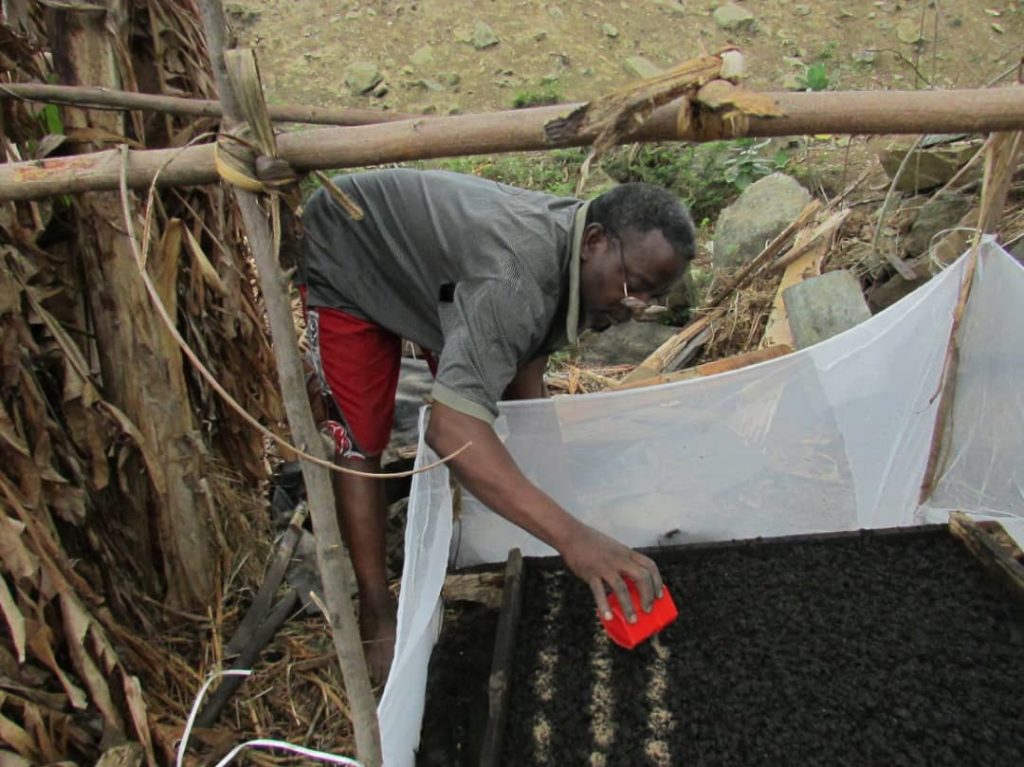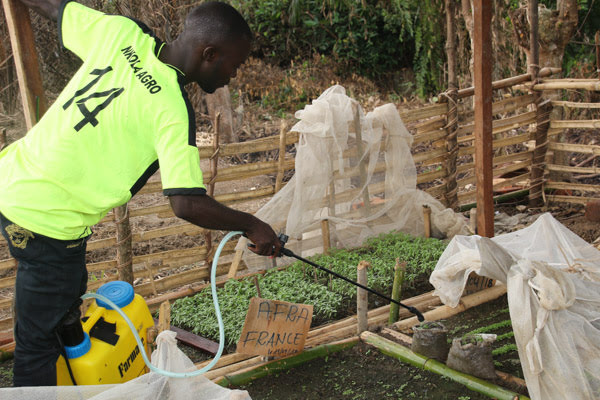Sowing
Download in pdfIMPORTANT! This process is extremely delicate. Plants are very fragile for a month after germination.

Preparing the seed bed
OR use wooden planks (approx 30cm deep) to make a free-standing seed bed in open ground.
from rain and direct sun making sure seeds have plenty of light (from the sides).
the seed bed with the following mix :
- 1/3 well-decomposed compost
- 2/3 local soil (OR 1/3 local soil + 1/3 sand if local soil is too heavy)
to obtain a light and fine mix. Remove any large or coarse particles that could hinder seed germination.
the soil to destroy weed seeds, pathogens (eg. damping off fungal disease) and larvae that could adversely affect seed development.
Method 1 - boiling water sterilisation : use a watering can and water with boiling water
Method 2 - solar sterilisation : dampen soil, cover with black tarpaulin and leave in direct sun for 5 days (maximum soil depth 15 cm).
Method 3 - heat treatment : heat the substrate over a fire for 15 minutes, turning regularly, then leave 24 hours to rest before use.

No pesticides will be needed with properly sterilised soil.
However, if treatment is required to combat insect pests, use a neem based solution (1%).
Sowing
Our experience indicates that a 1 m² seedbed using seed produced by La Maison de l’Artemisia network will yield approximately 200 plants.
the seeding area.
the packet to loosen the seeds and measure out 1 teaspoon of seed.
A study carried out in Nigeria in 2014 recommends soaking seeds in hot water (60°C) for 2-3 minutes to reduce the germination period and ensure stronger seedlings. The best germination rate was observed when seeds were soaked in sulphuric acid (10%). However, soaking in hot water is both easier and cheaper. [1]
1 teaspoon of seed with 10 teaspoons of sieved sand to dilute the seeds if they are clean. If the seeds have not been winnowed and are mixed with bits of flowers, then reduce the amount of sand accordingly.
Adapt the amount of sand if necessary for homogenous sprouting at optimal density (based on germination rate of seeds).
or water mister to fix the seeds.
You can use a clean sprayer that has not previously been used to apply chemicals or a watering can with a spray head. Alternatively, moisten a broom and shake to create a rain of small droplets. Do not use a watering can without a spray head.
Seeds must remain on the surface to germinate. Hold can or mister sufficiently high to avoid disturbing or moving the seeds.

morning and evening with a mister or very fine spray until transplanting OR use a capillary watering system by placing the perforated half canister in a non-perforated half canister half-filled with water.
IMPORTANT : moisten the soil only. Do not swamp the soil or the seedlings will rot!
with wire netting or untreated mosquito net after watering. Raise netting on sticks placed around the seedbeds to protect from pests.
followed by other toothed leaves (2 to 5 days if germination is good - up to 2 months).
all weeds by hand or with a hoe!

Seedbed growth :
With proper spacing between seedlings ( > 1 cm), leave seedlings to grow to 10 cm high.
If spacing is too small, separate seedlings once they reach 3 to 4 cm high and grow in individual pots.
Small plants can be transplanted once they reach a hand’s length ( (10 to 15 cm high).
Plants are hardy once about 10 leaves have formed and they can survive in a small space before being planted out.











